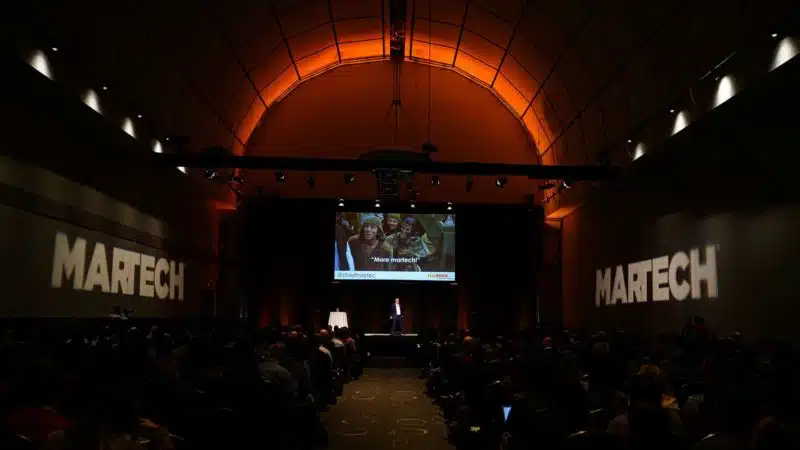4 ways to drive customer engagement through personalization
Personalized experiences can determine the success of customer engagement strategies.
Most marketing professionals know personalization is a key ingredient to successful customer engagement. But it’s not always clear how to put together a winning strategy.
“One path is traditional broadcast thinking,” said Ehren Maedge, GM of North America at customer engagement platform MoEngage, in his presentation at our MarTech conference. “We think about creating a small amount of content distributed to a broad audience. But there’s another path, and the other path is personalized, one-to-one engagement for each customer prospect.”

Maedge claims that “one-to-one personalization is the future.” If brands don’t adjust their strategies to fit this model, they’ll be displaced by alternatives. That’s what it takes to survive in a world filled with high consumer expectations.
Here are some personalization strategies to stay competitive in customer engagement.
Find hidden data
“Without the information, without the data, you don’t have any way to personalize,” said Maedge. “You don’t have any way to really truly engage customers on the basis.”
Your customer data could be hiding in many places: analytics tools, web browsing data, surveys, or mobile apps. Any user properties that capture geographic, demographic, or behavioral data are ripe for the picking.
“Be scrappy and creative with where you can get different parts of data,” said Maedge, “because the ultimate goal is to take that data and unify what you have.”
He added, “It doesn’t need to be perfect to start building that single view of the customer.”

Engage customers using many channels
“We’re talking about things like push notifications on the mobile app,” Maedge said. “We’re talking about in-app popups in a mobile app. We’re talking about SMS for some regions of the world. We’re talking about WhatsApp and of course everything between.”
Maedge pointed to what he calls the ‘accordion strategy’ of personalized marketing engagement. Brands that offer something of value in exchange for channel opt-ins are ‘expanding’ customer opportunities.
“If you’re going to expand the accordion, that’s how you play music,” said Maedge. “So expanding the number of channels that you have available to reach out to a customer is how you’re ultimately going to be successful.”
There are many ways brands can expand their value offerings in digital campaigns. Here are a few practical engagement examples.
- Sign up for SMS reminders and get $10 off;
- Download the mobile app and get free shipping; and
- Sign up for an email and reserve your place in line for a new product launch.
Use a customer data orchestration platform
Once customer data is gathered and consistently fed from many channels, marketers should look for ways to capitalize on the information. For this, they need an orchestration, or cross-channel campaign management, platform.
“Forrester talks about cross-channel campaign management, or CCEM platforms, as enterprise marketing technologies that support customer data management, segmentation, analytics, etc.,” said Maedge. “Forrester is identifying purpose-built tools that help marketers actually engage their consumers across channels.”
Since customers expect personalized experiences wherever brands find them, marketers must use tools that keep up. The key factor, however, is whether they’re able to respond to customer trends, not which platforms they go with.
“What’s important here is not to pick a vendor on the list,” said Maedge. “It’s important to see the trends and what vendors are doing.”
Implement augmented intelligence
“We feel that marketers need to lead on AI to magnify their results,” Maedge said. “But we think of it in a different framework. It’s really more about augmented intelligence versus artificial intelligence.”
Artificial intelligence is a popular topic and application that many marketers have used in their personalization efforts. Its machine learning capabilities can improve campaign efficiency. Yet many professionals like Maedge believe it fails to use valuable human elements, such as your hunches, experience, or perspectives.
Augmented intelligence — unlike artificial intelligence — seeks to amplify these elements. It can help marketers improve their engagement efforts by highlighting the human side of their brands while ensuring actionable data collection.
“When we think about AI that we really think about augmented intelligence,” said Maedge. “How do you take your hunches, experience, perspective, and put on the suit that makes everything you do and makes it more effective?”
He added, “We feel that taking advantage of AI and letting marketers lean on AI to do this is really where things are headed.”
Watch the full presentation from our MarTech conference here (free registration required).
Opinions expressed in this article are those of the guest author and not necessarily MarTech. Staff authors are listed here.
Related stories